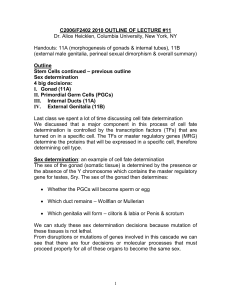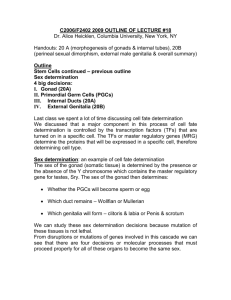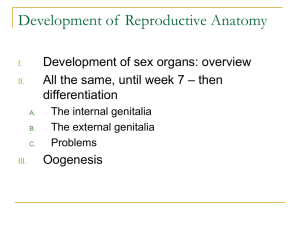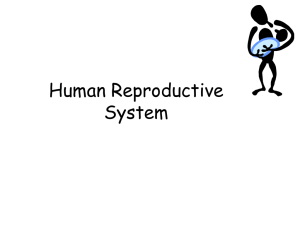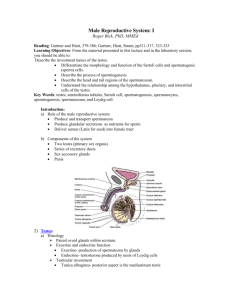C2006/F2402 2011 OUTLINE OF LECTURE #11
advertisement
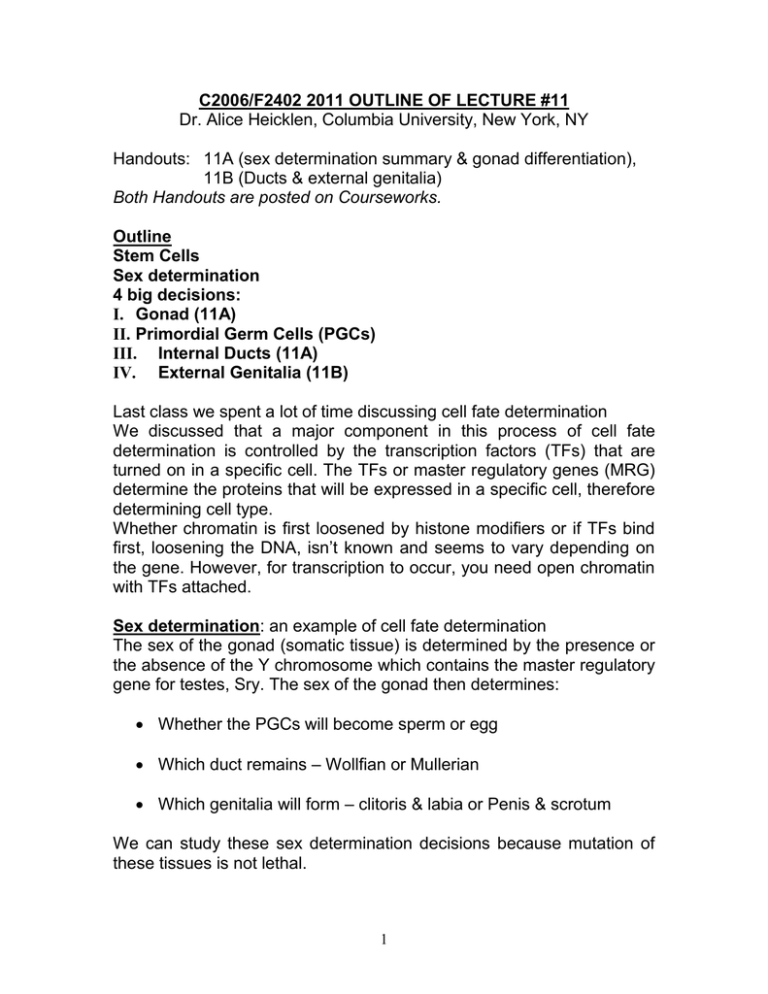
C2006/F2402 2011 OUTLINE OF LECTURE #11 Dr. Alice Heicklen, Columbia University, New York, NY Handouts: 11A (sex determination summary & gonad differentiation), 11B (Ducts & external genitalia) Both Handouts are posted on Courseworks. Outline Stem Cells Sex determination 4 big decisions: I. Gonad (11A) II. Primordial Germ Cells (PGCs) III. Internal Ducts (11A) IV. External Genitalia (11B) Last class we spent a lot of time discussing cell fate determination We discussed that a major component in this process of cell fate determination is controlled by the transcription factors (TFs) that are turned on in a specific cell. The TFs or master regulatory genes (MRG) determine the proteins that will be expressed in a specific cell, therefore determining cell type. Whether chromatin is first loosened by histone modifiers or if TFs bind first, loosening the DNA, isn’t known and seems to vary depending on the gene. However, for transcription to occur, you need open chromatin with TFs attached. Sex determination: an example of cell fate determination The sex of the gonad (somatic tissue) is determined by the presence or the absence of the Y chromosome which contains the master regulatory gene for testes, Sry. The sex of the gonad then determines: Whether the PGCs will become sperm or egg Which duct remains – Wollfian or Mullerian Which genitalia will form – clitoris & labia or Penis & scrotum We can study these sex determination decisions because mutation of these tissues is not lethal. 1 From disruptions or mutations of genes involved in this cascade we can see that there are four decisions or molecular processes that must proceed properly for all of these organs to become the same sex. Hermaphrodite = some of the gonadal tissue forms tissues of the ovary and some of the gonadal tissue forms tissues of the testes. Pseudohermaphrodite – an individual with some sex organs (gonad, ducts or external genitalia) are male and some sex organs (gonad, ducts or external genitalia) are female 4 big decisions during development: (puberty is a another story) I. Gonad = primary sex determination (11A) The first decision that needs to be made is by the gonad. The cell fate of the gonad in mammals is determined by the sex chromosomes: XX = female and XY = male. Gonad develops from two bilaterally symmetrical mesodermally derived genital ridges adjacent to the kidneys Genital ridge is bipotential Gonads - somatic tissues that form to support the germ cells Testes form sertoli (produce AMH) and leydig (produce testosterone) cells Ovaries form granulose and thecal cells (both produce estrogen & progesterone) Sry, the master regulatory gene for testes, causes the production of the proteins necessary to form the cells of the testes: enhances SF1 expression, with SF1 induces Sox9 expression which then turns on all genes necessary to produce sertoli cells Sertoli cells secrete a paracrine factor that activates a signaling cascade in the adjacent Leydig cells that maintains SF1 expression in Leydig cells, resulting in the production of the enzymes necessary to produce testosterone 2 A. Testes cell fate determination: Sry = master regulatory gene for Testes Expressed in sertoli cells On Y chromosome Turns on either directly or indirectly: TFs: -Sox9 -SF1 Signaling molecules: -AMH -Paracrine that turns on Enzymes for testosterone production in leydig cells -Testosterone - from leydig cells II. Primordial Germ Cells (PGCs) PGCs are derived from non-gonad tissue Derived from bipotential tissue Become sperm if they migrate into a testes and eggs if they migrate into an ovary – true of all of animal kingdom III. Internal Ducts (11A Top) Sertoli cells of testes secretes anti-Mullerian hormone (AMH) that destroys Mullerian duct Leydig cells of testes secrete testosterone, which is necessary to sustain & pattern the Wolffian duct Ducts, unlike the other 3 components of the reproductive tract, are not derived from bipotential tissue Wolffian duct = vas deferens, epididymis and glands Mullerian duct = oviduct, uterus, cervix and upper portion of vagina 3 Estrogen is necessary in female to: o Maintain germ cells and granulose cells o Pattern Mullerian duct DES: o Estrogen agonist o used from 1940-1970 to prevent miscarriage o causes Mullerian tubes to fuse less anteriorly decreasing uterus size o DES turns off Hoxa10, the master regulatory gene for uterus, in the portion of the Mullerian duct that normally forms the uterus. Normally Hoxa10 is expressed in the posterior end of the Mullerian tube (cervix and uterus) causing the posterior portion of the Mullerian duct to fuse to form the uterus. o Estrogen normally turns off Hoxa10 in the oviduct (anterior end of Mullerian tube) but not in the uterus IV. External Genitalia (11B bottom) Perineum – bipotential Male = penis, scrotum and anus Female = clitoris, labia major & minor and anus Corpus Spongiosum of penis must encompass urethra Dihydrotestosterone (DHT) in embryo required for perineum to develop male genitalia DHT in the adult regulates prostrate size and male patterned baldness For a summary of all components of sex determination see 11A Top 4
